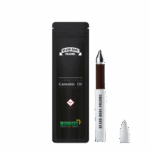Alcohol-related liver disease kills tens of thousands of Americans every year. It’s a gradual, often silent condition that can progress from fatty liver to cirrhosis without obvious symptoms until it’s too late. For people struggling with alcohol use disorder (AUD), the threat of liver damage looms large. But new research suggests an unexpected ally in the fight against this disease: cannabis.
A study published in Liver International examined over 66,000 patients with AUD and found that cannabis use was associated with significant reductions in liver disease risk. Those who used cannabis frequently enough to meet the criteria for cannabis use disorder (CUD) saw the most dramatic benefits—a 40% reduction in developing alcohol-associated liver disease (ALD), a 17% reduction in hepatic decompensation, and a 14% reduction in all-cause mortality.
These findings raise important questions about how we approach substance use, harm reduction, and the glaring contradiction in federal drug policy. Cannabis remains a Schedule I controlled substance, while alcohol—the very drug causing the liver damage in this study—is legal, widely available, and deeply embedded in American culture.
What the Study Found
Researchers from Virginia Commonwealth University and other institutions analyzed data from the TriNetX US Collaborative Network, a large multi-institutional database. They tracked adult patients diagnosed with AUD between January 2010 and January 2022, following them for up to three years.
The patients were divided into three groups: those with cannabis use disorder (CUD), infrequent cannabis users (CU), and non-cannabis users (non-CU). After matching for various health factors, 33,114 patients were included in each of the CUD and non-CU groups.
The results were striking. Cannabis use was associated with lower rates of alcohol-associated liver disease across the board. This included conditions like steatosis (fatty liver), hepatitis, fibrosis, and cirrhosis. The protective effect appeared strongest among those with CUD, followed by infrequent users, suggesting a possible dose-response relationship.
The study also found reductions in hepatic decompensation—a life-threatening stage where the liver can no longer function properly—and in all-cause mortality. In other words, people with AUD who used cannabis were not only less likely to develop severe liver disease, but they were also less likely to die from any cause during the study period.
How Cannabis Might Protect the Liver
The mechanisms behind these findings aren’t entirely clear, but researchers have some theories based on preclinical studies. Cannabis contains compounds called cannabinoids, the most well-known being THC and CBD. These interact with the body’s endocannabinoid system, which plays a role in regulating inflammation, metabolism, and immune responses.
CBD, in particular, has shown promise in animal studies for its ability to reduce liver inflammation and oxidative stress. It may work by suppressing inflammatory pathways, promoting the breakdown of fats in liver cells, and stimulating autophagy—a process where cells clear out damaged components. Some research also suggests that cannabinoids can modulate fibrogenic pathways, which are involved in the scarring that leads to cirrhosis.
The study authors note that the protective effect they observed is possibly attributable to CBD, though they caution that their analysis used cannabis use as a proxy and didn’t measure CBD intake directly. Still, the biological plausibility is there, and it aligns with other emerging research on CBD’s potential to support liver health.
Real-World Implications
If cannabis can reduce the risk of liver disease in people with AUD, what does that mean for clinical practice and public health?
For one, it opens the door to new treatment options. Alcohol use disorder is notoriously difficult to treat, and current therapies have limited success rates. If cannabinoid-based medications could be developed to target liver protection, they might offer a valuable tool in managing AUD and its complications.
There’s also the harm reduction angle. Many people with AUD continue to drink despite knowing the risks. If cannabis use can mitigate some of the liver damage caused by alcohol, it could serve as a bridge therapy or a way to reduce harm while someone works toward sobriety. Some evidence already suggests that people who use cannabis-infused beverages tend to drink less alcohol, and CBD has shown potential in reducing alcohol cravings and withdrawal symptoms.
There’s a question of access. In states where cannabis is still illegal, people with AUD can’t legally obtain it, even if it might help their liver. And even in legal states, the lack of standardized dosing and product regulation makes it difficult for patients and doctors to know what they’re working with.
The Irony of Federal Policy
Here’s where things get absurd: alcohol is the substance causing the liver damage in this study, yet it’s perfectly legal and widely marketed. Cannabis, which appears to reduce that damage, remains a Schedule I drug under federal law. That classification means the government considers it to have no accepted medical use and a high potential for abuse—a stance that’s increasingly at odds with the scientific evidence.
The consequences of this policy are far-reaching. Federal prohibition makes it harder to conduct rigorous clinical trials on cannabis. Researchers face bureaucratic hurdles, limited funding, and restrictions on access to cannabis for studies. This slows the pace of discovery and leaves patients without clear guidance on whether and how cannabis might help them.
Meanwhile, alcohol remains one of the leading preventable causes of death in the United States. According to the CDC, excessive alcohol use is responsible for approximately 178,000 deaths annually, based on 2020–2021 data.
Alcohol-related liver disease is a major contributor to that toll. Yet there are no age restrictions on alcohol advertising, no federal warnings about liver damage on every bottle, and no meaningful effort to reclassify alcohol as the dangerous substance it is.
The double standard is hard to ignore. We arrest people for possessing a plant that might help prevent liver disease while allowing the legal sale of the drug that causes it.
Limitations and Cautions
This study, as impressive as it is in scope, comes with important caveats. It’s a retrospective observational analysis, meaning it looked at existing medical records rather than conducting a controlled experiment. That introduces the possibility of confounding factors—variables that might explain the results without cannabis being the cause.
For example, people with CUD might have had more frequent healthcare encounters, leading to earlier detection and treatment of liver issues. Or they might have consumed less alcohol on average than non-users, though the study did attempt to control for this. The researchers also couldn’t measure actual patterns of alcohol and cannabis consumption, only diagnoses in medical records.
Another limitation is that the study used cannabis use as a proxy for CBD exposure. Cannabis products vary widely in their cannabinoid content. Some are high in THC and low in CBD, while others are the reverse. Without knowing what patients were actually consuming, it’s hard to pinpoint which component—if any—was responsible for the protective effect.
The authors acknowledge these limitations and call for further research, particularly randomized controlled trials that evaluate CBD’s impact on ALD using appropriate dosing and treatment duration.
Where Do We Go From Here?
The findings from this study don’t provide all the answers, but they do point toward a new avenue for research and treatment. Modulation of cannabinoid receptors may offer a novel target for developing therapies for alcohol-associated liver disease. That’s a significant possibility, given how few effective treatments currently exist.
For clinicians, this research shows the importance of having open, nonjudgmental conversations with patients about substance use. Many people with AUD may already be using cannabis, either recreationally or as a way to manage symptoms. Understanding their patterns of use could help inform treatment plans and harm reduction strategies.
For policymakers, the study provides more evidence that cannabis prohibition is outdated and causes harm. Declassifying cannabis at the federal level would facilitate more research, improve access for patients who might benefit, and reduce the criminalization of a substance that appears to have legitimate medical applications.
And for individuals struggling with alcohol use disorder, this research offers a glimmer of hope—not as a cure, but as a potential tool in the larger effort to manage a difficult condition and protect their health.
It’s ironic: the substance that might help save lives remains illegal, while we sell the one destroying them on every street corner. Until that changes, we’ll continue to face the consequences of a drug policy that prioritizes politics over science and punishment over public health.
- Is LSD Helpful for Treating Alzheimer’s? New Studies Aim to Find Out
- Heavy Cannabis Users Who Drink are Much Less Likely to Suffer Liver Diseases
- Sharon Letts Educated Stoner Pt. 3: Cannabis & Cancer
- Can Ketamine Treatment Help People with Alcohol Use Disorder?
- Scientific Review Highlights The Hidden Power of Phytocannabinoids in Treating Neurological Disorders

















